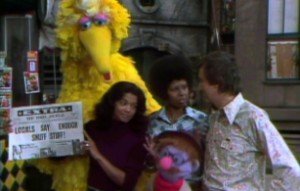Sesame Street Ep #796
The seventh season of Sesame Street debuted on PBS on December 1st, 1975–fairly late, given it usually started up in September or October–with episode #796, which I watched for today’s post (and is available on the Sesame Street: Old School Volume 2 DVD set). And while I can’t really judge the entire season based on the premiere alone, it would seem that not much has changed in Sesame Street‘s evolution from last year to this one. There is still very little connective tissue holding the episode together, and, in some ways, I found it the least interesting one to watch thus far, but I might just be growing a bit impatient with watching full episodes of this by this point. There’s some great individual stuff here, but, as an hour of television, it doesn’t hold up well.
Rather than attempting to recap the whole thing–which I don’t think would be very illuminating or interesting, particularly after so many similar past recaps–I’ll just go over the main points of interest. Although it doesn’t run through the entire episode, being abandoned about halfway through, there is a rudimentary plot surrounding Big Bird and Snuffy. Unfortunately, however, it doesn’t amount to much other than maintaining the running thread of people not believing Big Bird about his friend’s existence. In the opening scene, this is downright sad, given Snuffy clearly knows all of them. In fact, the sequence consists almost entirely of poor, Eeyoreish Snuffy showing us all of the people on Sesame Street who don’t realize he’s there.
Later on, we have another scene of Big Bird trying to convince his friends that Snuffy is real and all of the humans responding not only with consternation but outright belligerence. There is a level of fascination to just how cruel and regressive this seems to modern eyes. For a show that could be so wise when it came to childhood psychology, particularly one which was created under the advisement of a board of psychiatrists using the best knowledge available at the time, it’s downright bizarre that they deemed it all right to show adults getting this impatient with a child for having what they thought was an imaginary friend. After all, worst case scenario, even if he were making Snuffy up, what’s the big deal? So he has an active imagination. Shouldn’t that have been encouraged?
And that makes it hard to tell where the show’s sympathies lie. Are we supposed to be amused by the adults’ dismissing Big Bird out of hand? Are we supposed to be frustrated with them for refusing to accept something we know to be true? There are much kinder ways of helping a child who you think is having trouble distinguishing between reality and fantasy than getting angry with them. And so even when a reporter, Headline Howie, appears to report on this “breaking news story,” demonstrating numerous headlines in the old Variety vein–for example, “LOCALS SAY ENOUGH SNUFF STUFF,” and “SNUFF NOT PUFF SAYS BIRD IN HUFF”–it’s difficult to find it very amusing, not to mention hard to keep a very different connotation of the word “snuff” from springing to mind.
And, as I previously mentioned, the next street scene bears absolutely no connection to these first two. It’s a song called “A Postcard from Amy,” in which Grover is reading a postcard from his friend, who tells him how her day is going and that it’s a bit cold. Grover sings the words to Maria, who sings slightly different words to Bob, who sings slightly different words to Herry Monster. Although in both of these latter instances, the words have shifted, the general meaning remains at the same. Herry, however, misinterprets what he heard and sings to David, Gordon, and Luis that Amy has a cold, and they proceed to sing to other people increasingly incorrect stories that end up with all of Sesame Street thinking Amy is practically at death’s door in the hospital.
Overall, it’s a cute scene, except for the fact that, by the end, all of the adults, even Maria and Bob, are singing with the Muppets about visiting her at the hospital, which makes the adults look rather foolish, and, when taken in context of the earlier street scene, also makes them seem kind of horrible. Granted, it’s a Muppet who first steered the story off-course, but the adults are no better about maintaining the story they heard, warping it along with their foamy companions until there’s no resemblance to what was originally said to them. And, yes, it’s a comment on human nature, but, shortly after we heard them refuse to believe Big Bird, watching them then embellish their own tall tale seems pretty damning, particularly given it indicates they don’t listen to anybody. And, yes, I’m fully aware that I’m overthinking this!
The final street scene of the episode isn’t really problematic at all, but it’s also rather boring and entirely Muppetless. Luis has a typewriter at his shop that he’s been having trouble fixing, but Maria’s able to figure it out, and, when she’s done, she gives it to David as a birthday present but not before temporarily pretending she doesn’t realize it’s his special day and then finally giving him his surprise. Now, there are some interesting things about the scene today: for one, I love how subtly and straightforwardly they present Maria, a woman, being able to perform a repair that a man couldn’t, a great message for young female viewers of the time; secondly, from the perspective of hindsight, it’s funny to see Luis basically helping Maria in her courtship of another man, given we now know that they will end up living happily ever after together. I don’t know whether the writers at this point had any inkling that this would eventually happen, but there seem to be hints of Luis’ feelings. I mean, the looks he gives her as she finishes up on the typewriter! The fact that he’s so obviously attracted to a capable women who can school him in his own profession is a definite checkmark in the “Why Luis Is Awesome” column.
And, as I said before, the episode does have its other strong points. There’s a lovely Ernie and Bert nighttime scene that features no Ernie-messing-with-Bert whatsoever. Bert’s having trouble sleeping, and all his best buddy does is help him by suggesting he think of something he loves to do to help lull him to Dreamland. Bert decides to think of ice skating, and soon he fades into unconsciousness as we see a full-sized Bert gliding on the ice. This was the first in a series of short scenes that the show featured in which Sesame Street Muppets were shown ice skating–in actuality, they were dancers in full-body Muppet costumes from the Ice Follies, which was doing a Sesame-Street-on-ice show that year. And it really is a beautiful, peaceful sequence that evokes all kinds of wonder and joy.
Pages: 1 2



